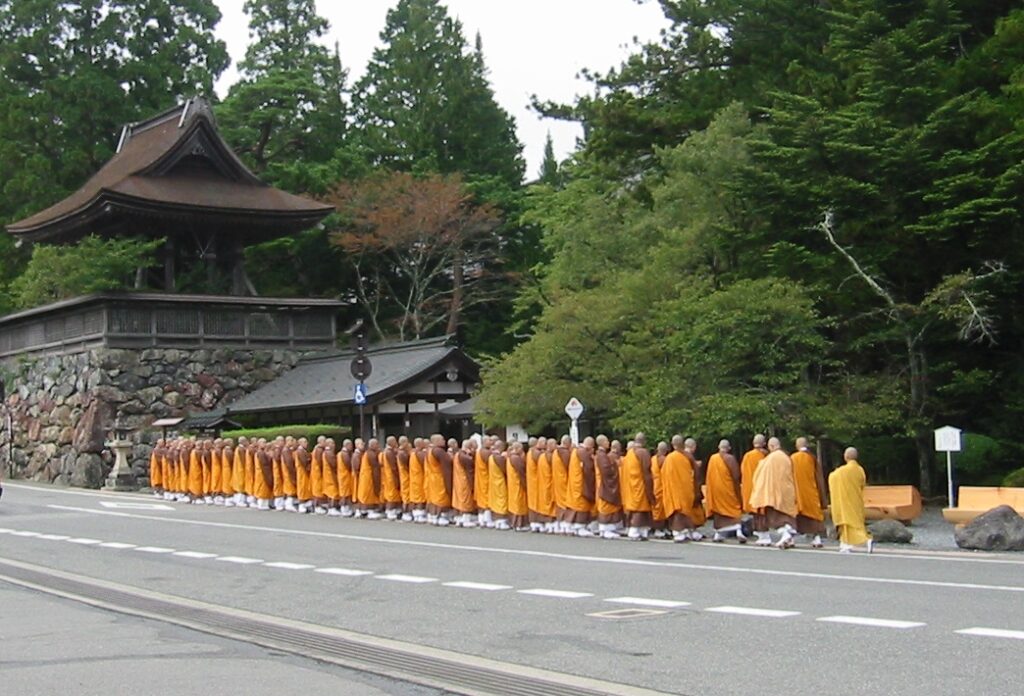While Saicho and his disciples focused on integrating esoteric and exoteric teachings to produce what has come to be called “Original Enlightenment Thought,” Kukai developed a “metapraxis” to allow Shingon practitioners to attune themselves to the intimations of Dainichi as the Cosmos who expounds the truth. “The point of Shingon practice is to intentionally accord with, or inter-resonate with, Dainichi’s movements, mirroring the macrocosmic world in one’s own microcosm” (John Krummel).
Kukai’s interpretation of Mahavairocana/Dainichi as Buddha-as-cosmos may be regarded as an expansion of the Heart Sutra’s well-known verse “form is emptiness, emptiness is form.” There had not been in Madhyamaka or Yogacara any attempt at “entering emptiness from the side of the form,” that is, from the side of the world of phenomena, in order to engage with emptiness. There was a sense in which, as Yoshito Hakeda writes, “the Dharmakaya hitherto had… been regarded as formless, imageless, voiceless, and totally beyond conceptualization. By defining Mahavairocana as the Dharmakaya, Kukai identified Mahavairocana with the eternal Dharma, the uncreated, imperishable, beginningless, and endless Truth.” Dainichi, that is, the Buddha-as-cosmos, can be known through “emulation” and “resonance.” He is “expounding the truth,” he is “preaching” to you. To properly learn from him, however, you must not follow the way of western science, which requires that you detach yourself from the world in order to observe it. In Thomas Kasulis’ words, you must, instead, “fathom the universe as an intimation of Dainichi’s personal style by deliberately harmonizing your own bodily, verbal, and mental styles with Dainichi’s.”
Kukai worked out his metapraxis on the basis of the “Three Mysteries” (Skt: tri-guyha; Ch: san-mi; Jap: sanmitsu), which Yoshito Hakeda refers to as “the suprarational activities or functions of the Body, Speech, and Mind of Mahavairocana.“ Thomas Kasulis prefers to call them the “Three Intimacies” since mitsu means both “secret” and “intimate.” “Through the praxis of the three intimacies, we achieve a profound, intimate, detailed engagement with the processes of reality.”
These three Mysteries should not be understood as faculties we would “have” with which we could resonate with a cosmic Buddha that would be outside of us. We are ourselves part of the cosmos, so Dainichi is within us, as it were, self-expressing through our body, speech, and mind.
Directly relevant to this view is the concept of kaji, translated as “grace” or “empowerment.” Yoshito Hakeda explains that ka is “the compassion of the Buddha pouring forth on the heart of sentient beings, like the rays of the sun on water” and ji is the heart of sentient beings which keeps hold of the compassion of the Buddha, as water retains the rays of the sun.” In Krummel’s words, “the realization of enlightenment cannot be attained on one’s own.” The concept of kaji involves “both the Buddha’s great compassion and the practitioner’s piety, devotion, or faith, which in their correspondence, act together in the attainment of enlightenment.”
“On the basis of kaji, the three mysteries of the hosshin and the three corresponding forms of activities of sentient beings inter-permeate. That is, our own bodily, verbal, and mental activities are already expressions of the three mysteries of the hosshin. This inter-permeation is hence “always already,” and yet what is lacking for the most part is our awareness of it that would realize it. That is why Kukai, following the Dainichikyo, prescribes the ritual practice of bodily acts, verbal acts, and mental acts. Bodily acts involve mudra-formations — these are complex series of gestural movements of the hands and fingers in coordination with mantra-chanting and visualizations —, meditative bodily postures, and the handling of ritual instruments. Verbal acts involve mantra-recitations and other forms of prayer formulas or chants and verses (dharanis). And mental acts involve visualizing or focussing upon mandalas or the figures of Sanskrit mantra letters as well as visualizations (kanso, kannen) of deities or buddhas — a realization of self and world in the sense of both transformation and awakening as their fruit.”
Specific practices – a particular mudra, mantra, and visualisation, may be given by a teacher to a practitioner on the basis of their particular stage of development, but such practices are also incorporated into rituals which play a central role in Shingon. It would, however, be incorrect to take Shingon (with Tendai which also offers esoteric practices) as the only Japanese school where rituals are used as part of the path. It is only because of the rationalist bias prevalent in the West that we have by and large jettisoned rituals from our Buddhist centres to focus exclusively on sitting meditation. The emphasis on rituals goes hand in hand with the Asian culture’s reliance on experience, rather than scriptures, to train practitioners. It is part and parcel of the search for innovative ways to teach Buddhism to ordinary people who, at the time, were often illiterate and could not read the texts, but the ritual approach is also beneficial to educated folk who tend to overthink when encountering challenges.
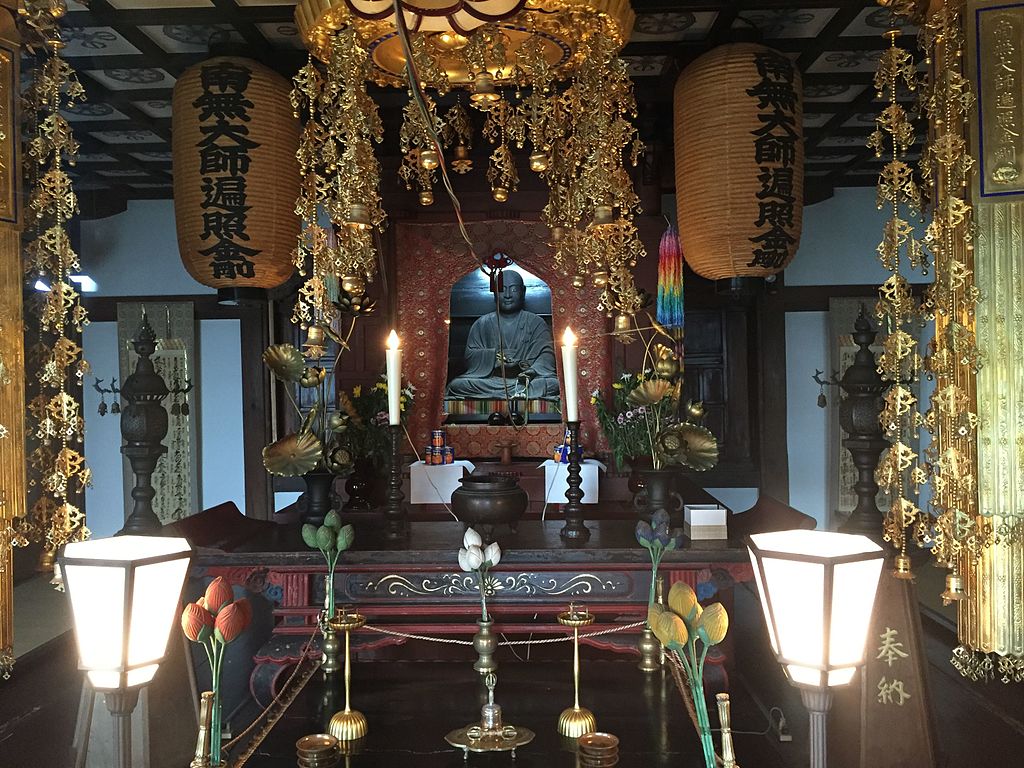
“With successful completion, this practice of the three mysteries, which initially has the aspect of “with form” – that is, in rituals -, comes to occur naturally, no longer restricted to its ritualized context. That is, the individual’s every action in daily life, without ritual form, comes to intentionally reflect the enlightened body-and-mind of the Buddha and its three mysteries. Every word uttered is thus a mantra, every bodily movement a mudra, and every thought samadhi” (Krummel).
The Mystery/Intimacy of Speech
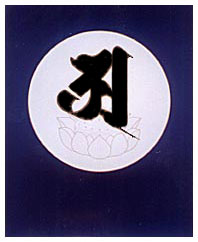
Following Kasulis’ text, I’ll focus on each intimacy, starting with speech. “The Shingon practice of verbal intimacy is to intone a sacred syllable or phrase: a mantra. Therefore, Dainichi’s verbal intimation is a sound. What sound? We can hear the sound of a birdcall, but what is the sound of a sunset or a telephone pole? The answer lies in the function of mantras, or as they are called in Japanese, shingon – “truth-words.” Particular to Shingon ritual are six “seed mantras,” namely A, Va, Ra, Ha, Kha, and Hum. When reciting those mantras with the correct posture and mental attitude, one becomes attuned to the basic “resonances” or “echoes” (kyo) constituting the cosmos. These voiced seed mantras are not themselves the basic constituent of reality, but by intoning them within the proper ritualistic context, one becomes sensitive to the “truth words” inaudible to ordinary hearing. That is the cornerstone of Kukai’s metaphysics: ‘reality as resonance’.”
Kasulis explains that whereas looking at the world with your eyes “generates a perspective in which you are separate from the thing seen, sound by contrast, can engulf you from all directions.” Sound, therefore, has been given to you to help you harmonise with the cosmos. Never forget that it is not that “you have” sound. Because you are part of the cosmos, the Buddha-as-cosmos is within you giving you sound. Kasulis writes: “As a manifestation of his enlightenment, Dainichi intones the sacred syllables or, more precisely, Dainichi is the intoning of the syllables.” Each of the six elements, as they were understood in the East Asian tradition – earth, water, fire, wind, space, and consciousness – “accords with the resonance from one of the six seed mantras being uttered by Dainichi.”
This may sound strange to western minds, but don’t we all use words borrowed from the vocabulary of sound to express a correspondance with a particular understanding? We may say to a friend, “I do resonate with what you say.” The verb “to attune” means to harmonise, to adjust, to bring into accord, to make agree. This also brings to mind a poem by Thomas Eliot: “Music heard so deeply, it is not heard at all. And you are the music while the music lasts.” Sound takes you out of your ordinary self to become the whole reality.
So, Kasulis concludes: “From the standpoint of engagement, to be a buddha is not a change of ‘what’ you ‘are’, but in ‘how’ you ‘know’. When achieving enlightenment, you realize what you have been all along, as aspect of Dainichi’s function, a small subset of the resonances composing the universe … you can realize how your small part of the whole contains the pattern of the whole within it.”
Of course, in Shingon, practitioners do not practice the mantra by itself, as is done in later schools such as Pure Land and Nichiren. The mantra is accompanied by visualisations of mandalas and mudras. “As Dainichi’s act is one, the three practices are one.”
The Mystery/Intimacy of Mind
Thomas Kasulis writes: “Dainichi’s actions do not merely fill the universe with resonance; they also lend it structure and pattern, what is understood to be Dainichi’s mental function … As the mantra is to the verbal intimacy, the mandala is to the mental. The Sanskrit term mandala (Jap mandara) simply means circle, an appropriate name given the basic shape of the mandalas themselves: sets of circles, either concentric or juxtaposed within squared off areas. In ancient Indian religious life, the mandalas were initially drawn as a site for the deities to assemble during rituals. Shingon scholars often interpret the etymology of the word mandala to mean “possessing the essence.” The essence of what? Of the universe as the activity of Dainichi. So, a mandala is a sacred site, what I refer to as a holographic entry point in Shingon praxis, that is, a point at which the practitioner recognizes oneself to be part of Dainichi (the whole) and at the same time a holographic reflection of the configuration of that whole … In a sense, in focusing on a mandala, my mind is focusing on its own mental configurations that are, in turn, the configuration of everything.”
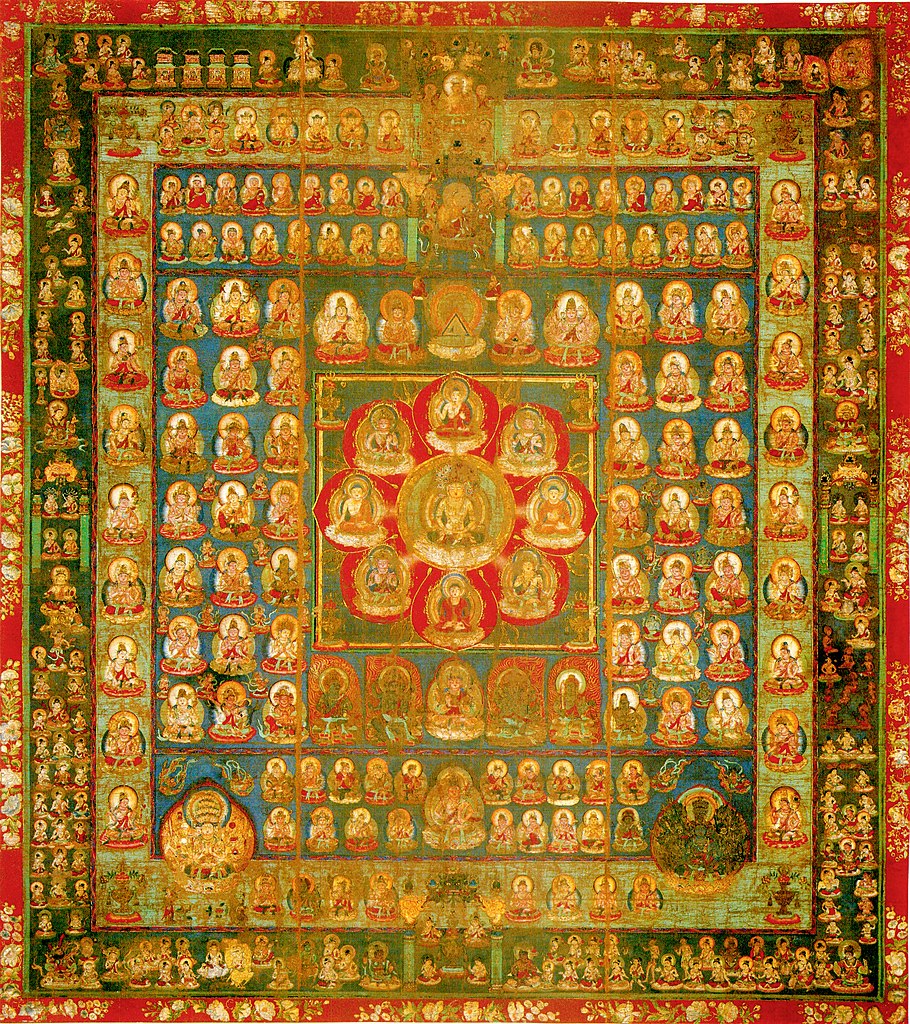
At the heart of Shingon mandala practice is the “two world” mandala – based on the two sutras Kukai’s Chinese master Huiguo had transmitted to him: the Mahavairocana Sutra and the Vajrasekhera Sutra (also called the Sarvatathāgatatattvasamgraha Tantra). The Womb mandala, (Skt garbha; Jap taizo) also referred to as Matrix mandala, is based on the former, while the Diamond Realm (Skt vajra; Jp kongo) is based on the latter. These two mandalas evolved separately in India and entered China by different routes, but in China they subsequently came to be regarded as forming a pair. The Womb mandala is hung on the western side of the Shingon altar, and represents the young Mahavairocana; the Diamond Realm mandala is hung on the eastern side, and represents the fully realised Mahavairocana. The two mandalas are said to be non-dual, that is, they represent two aspects of the same reality. “From the philosophical standpoint, we can regard the Womb Mandala … as a depiction of the principle of “the cosmic embodiment expounds the truth,” hosshin seppo … By visualizing the mandala, therefore, you enter the innermost, most intimate structure of the universe, the source of everything. In effect, the mandala pictorially expresses the procreative or, more precisely, emanative function of the cosmic embodiment’s activities.”
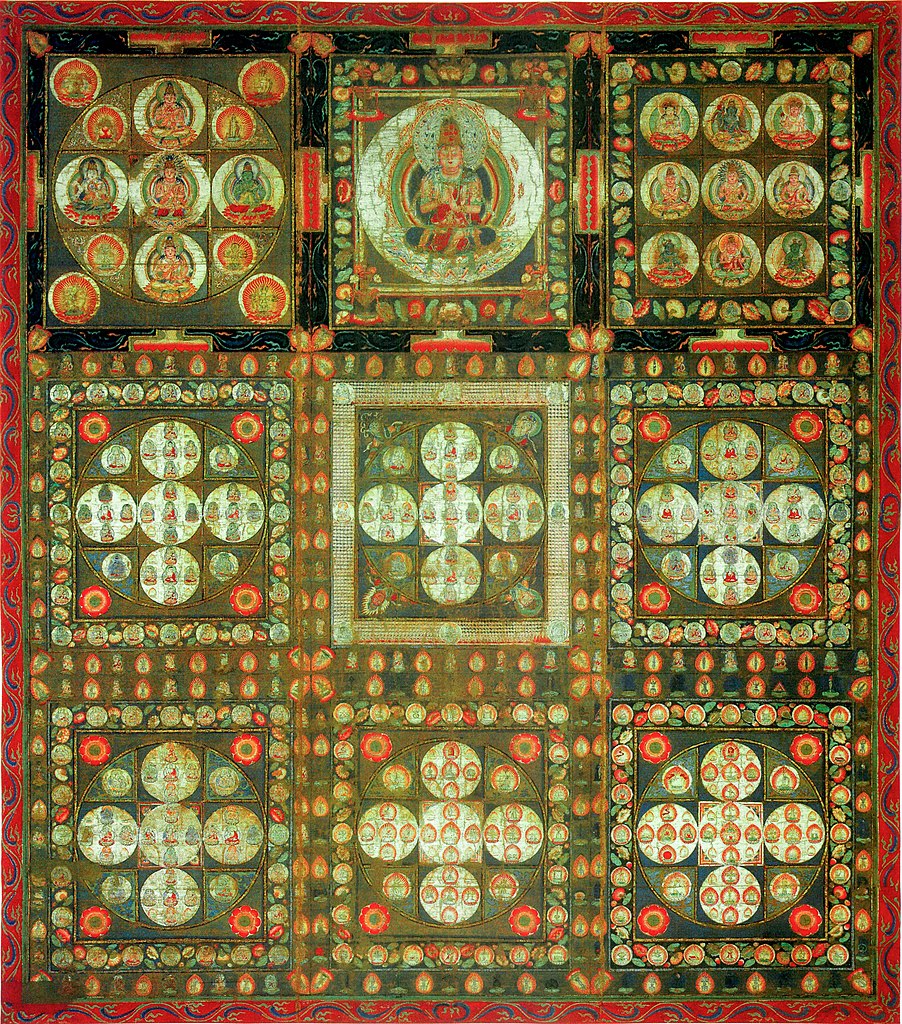
“Whereas the Womb Mandala represents the metaphysical principle, the Diamond Mandala depicts the attainment of wisdom (chi) … Unlike the Womb Mandala concentric organization, the nine squares of the Diamond Mandala are typically interpreted as a spiral symbolizing the flow of spiritual empowerment in practice … Dainichi is again at the centre and the Buddha’s empowerment moves clockwise around the mandala … If we can associate the Womb Mandala with the “cosmic buddha expounds the truth,” hosshin seppo, we can think of the Diamond Mandala as related to the principle of sokushin jobutsu, “this very body attains buddha.” That is, it depicts the progress toward enlightenment and its immediate accessibility.”
Kasulis adds that “we could say that hosshin seppo characterizes Shingon metaphysics, the structure of embodiment behind events (physis), whereas sokushin jobutsu characterizes Shingon metapraxis, the structure embodiment behind practice.”
The Mystery/Intimacy of Body
When Kukai affirms that we can attain enlightenment “in this very body” (sokushin jobutsu principle), does he only mean that we do not need thousands of lifetimes, before we can attain it, as taught in Theravada? Or is there a specific reason why he uses the word “body,” rather than “lifetime”?
For Kukai, the universe is the “embodiment” of Dainichi. So there is a sense in which, “enlightenment is attainable to us in this embodiment because Dainichi is embodied right now as this world, including our very own bodies.” Shingon praxis is therefore a means to identify with the buddha through emulating “Dainichi’s personal style,” using the three intimacies, so that “one knows the buddha-as-cosmos not by “moving around it” but by “entering it.” Kasulis proposes that we consider the following Zen koan to intuitively grasp what “entering it” means: “The student asked Master Xuansha how to enter Zen.The master replied, ‘Do you hear the rushing of the mountain stream? Enter there.’”

Do you hear the rushing of the mountain stream? Enter there.’”
Kasulis here draws our attention to the fact that, though Kukai uses only one term to refer to the body, namely “shin,” he uses three terms to refer to the mental: “shiki” (consciousness) used in connection with the six great elements; “i” (the mental) used in reference to the three intimacies; and “shin” (mind) used in connection with either the intimacies or the mental-and-affective faculty that forms experience.” Note that the “shin” used for the body and the “shin” used for the mind are transliterations of two different characters. Then he asks: “How do these three notions of the mental interrelate? And how do they overlap with the body?”
Kasulis holds that the following statement by Kukai may contain the answer: “Wherever the six great elements reach, that is my body. Wherever the ten worlds exist, that is my mind (shin). Since one of the six elements is consciousness (shiki), that brief statement gives us a clue about the connections among body (shin), consciousness (shiki) and mind (shin). Identified through empowerment with Dainichi’s body, the person’s body permeates the elements constituting the universe including the element of consciousness, but the person’s mind structures that universe into ten, which is to say all, worlds. So the body (shin) is essentially the bodily intimacy (shinmitsu), the embodiment of Dainichi’s style as one’s own. Through Shingon practice, one can identify with the cosmos itself, but that cosmos is not just a grand unintelligent machine since one of its elements is consciousness (shiki) … What could it then mean to regard consciousness as a constitutive element of reality? To pose the question in terms akin to the mind-body problem in western philosophy: how does this consciousness relate to body?
Kasulis here introduces the notion of a “proprioceptive cosmos,” and asks us to do “a little bodymind experiment: with eyes open, touch the fingers of your right hand with your left index finger; then, close your eyes, and do the same thing. It is not difficult at all! … To do the exercise, you depended on your proprioceptors (“towards-oneself-directed receivers”) to give you information about the location of your hands and fingers. Those neural sensors are deep within your flesh and continuously process information about such phenomena as muscle tension to inform you about, among other things, the location and movement of your limbs. Without them, you could not walk either.” Anyone who can touch-type will agree that their fingers “know” where each key is on the keyboard. Kasulis insists that, even when the skill is learned, it could not have been learned if we did not have in-built neural sensors in our body. It would, however, be incorrect to conclude that consciousness is a property of matter, as a typical western mind probably would. “Kūkai does not reduce reality to either mind or matter; his perspective is neither merely idealist nor merely materialist.” (John Krummel). “That consciousness is the bodymind of self-awareness, a self-awareness that does not objectify the self. It contrasts with your intellectual self-consciousness that is your mind (as shin). That mind is aware of yourself as an object, self-consciously watching your left finger touching your right fingertips.”
So, “when Kukai says … that enlightenment is to “know your own mind,” he probably means something more than understanding your disembodied sequence of thought. Furthermore, since consciousness (shiki) is one of the basic six elements of the cosmos, the entire universe, not just you, is proprioceptive. The universe knows where and how it is without thinking about it.”
Shiki (consciousness as the 6th element) and shin (reflective mind) are two entirely different functions: “If (the proprioceptive) consciousness (shiki), as one of the six elements, is on the border between the micro- and the macrocosmic side, mind (shin) is more decidedly on the macrocosmic side, the level of ordinary perception in everyday life. Mind is the reflective function, involving both affect as well as thought, that interprets the macrophysical as a world, a world in which that mind lives … Each of us lives in the world as structured and interpreted by our own minds. There are multiple lived-in worlds, each depending on the assumptions and value orientations we give them. Of course, these are not literally worlds, but more mindsets, the frameworks in which our minds dwell, what Shingon calls the jushin (literally “mental abodes”). A mindset is a fixed web of beliefs and values from within which we experience and interpret the world.”
And these “mindsets” are what Kukai presents in the Jujushinron, translated as The Ten Stages of the Development of Mind, a massive work he wrote in 830, five years before his death.
Sources:
Thomas P. Kasulis – Engaging Japanese Philosophy
John W. M. Krummel – Kukai entry in the Stanford Encyclopedia of Philosophy
Yoshito S. Hakeda – Kukai: Major Works
